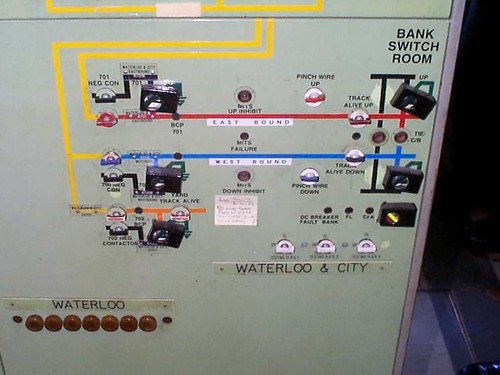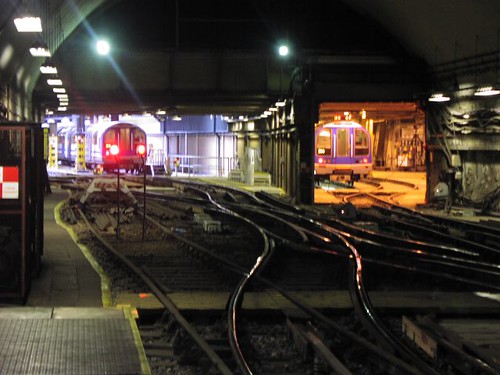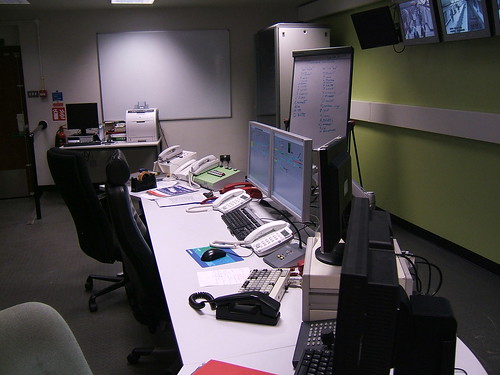One of the lines I've worked on is the Waterloo and City. At just under a mile and a half in length the Waterloo & City is the shortest of the London Underground railways now operated by Transport for London but it has a lot of interest.
In the post Waterloo Station, London (Part 2) I explained that the London & South Western Railway (L&SWR) which built the main line terminus at Waterloo had an ambition to extend their line eastwards. The Waterloo and City Railway Company was incorporated in 1893 by an Act of Parliament. Although independent from the L&SWR, no less than five of the eight directors of the new line were directors or employees of the L&SWR! Construction of the double-track Waterloo and City Line started in 1894 and it was opened, using electric traction, in 1898. It is 1 mile 46 chains long with two single-bore iron segment tunnels of varying diameter up to 12ft 9in.
The L&SWR operated the Waterloo and City railway from its opening, later purchasing the line outright. At the Grouping, the line passed to the Southern Railway and, upon Nationalisation, to British Railways, ending up part of London Underground in 2004. This history has produced a unique line.
Rolling stock has always been stabled and serviced at a cramped depot below ground level beyond Waterloo station. A siding just north of the Waterloo & City underground station was provided with a lift (built by Armstrong) to the main-line sidings, allowing underground vehicles to be transferred to and from the main lines. The railway generated its own electricity at a power station adjacent to the depot and the Armstrong Lift was also used to receive wagons of coal for the power station. The Armstrong Lift was removed to allow construction of the Waterloo International platforms to serve the Eurostar services, since when the Waterloo & City has been completely isolated from other railways.
The L&SWR started to electrify its suburban main line network from Waterloo in 1915, constructing a large, new power station at Wimbledon to supply the power. The sub-station at Waterloo main line station was arranged to also supply power to the Waterloo & City line.
As part of a comprehensive modernisation by the Southern Railway in 1940, the bare copper 'pinch-wires' which form part of the present tunnel telephone system were added. This system allowed the driver to communicate with the signalman at Waterloo (Waterloo & City) and the power supply operator in the main line substation at Waterloo. In 1972, control of the main line substation at Waterloo was transferred to Raynes Park. The original tunnel telephone control panels were left in Waterloo main line substation but the telephone circuits were extended to Raynes Park and a remote reset facility for the tunnel telephones was provided through the electro-mechanical telemetry system for power control.
 The Electric Control Room at Raynes Park presently controls traction power to the Waterloo & City. This view shows the small part of the large mimic diagram relating to the Waterloo & City.
The Electric Control Room at Raynes Park presently controls traction power to the Waterloo & City. This view shows the small part of the large mimic diagram relating to the Waterloo & City.
At present, traction power is still provided from the Network Rail Main Line Traction Substation via d.c. track feeder cables. There are two tunnel traction sections, one for the Down or Westbound line (section 700), one for the Up or Eastbound line (section 701) line. The Waterloo Depot area, which is not provided with tunnel telephones, forms a third traction section (section 702). Traction sections are fed via high-speed d.c. circuit breakers, similar to London Underground standard practice. At the remote end of the Up and Down lines, Bank, a Track Paralleling Hut was provided to minimise voltage drop. However, this feature was never commissioned and the railway operates as two single-end fed traction sections.
A new Traction Substation is being completed within Waterloo station near the Waterloo & City line and, once this is commissioned, the Network Rail Main Line Traction Substation will no longer be involved in the operation of the Waterloo & City line.
In 1989 Network South East, who were by then responsible for the line, ordered replacement rolling stock of the LUL Central Line pattern, providing five 4-car sets. Cranes were needed to remove the old rolling stock and deliver the new trains to the depot area, since the Armstrong Lift had been removed as mentioned above. Some civil works were needed to accommodate the new stock and the current collection system was changed from third rail to standard London Underground fourth rail pattern in 1992.

Present Waterloo & City vehicle.
 The depot at Waterloo, viewed from the Arrival platform, in 2004.
The depot at Waterloo, viewed from the Arrival platform, in 2004.
Westinghouse replaced the old signalling system in 1992 with a relay interlocking controlled from an 'NX' mosaic panel.
 The 'NX' signalling control panel at Waterloo in 2004.
The 'NX' signalling control panel at Waterloo in 2004.
Around 2007, a new Service Control Centre was constructed within Waterloo station. This was provided with a solid-state signalling interlocking system controlled from workstations. The 1992 Westinghouse signal box has been retained as an Emergency Service Control Centre.
 The present Service Control Centre at Waterloo.
The present Service Control Centre at Waterloo.
Related information on other websites
Clive's UndergrounD Line Guides form an excellent reference to all of London Underground. The Guide for the Waterloo and City line is here.
There's a Wikipedia article here.
Related posts on this website
All my posts on London Underground can be found here.
Books
In my introductory post London Underground and Jan, there's a list of books about London Underground. From this list, these two are of particular relevance to the Waterloo and City Line:-
[ 1] 'The Waterloo & City Railway' (a very detailed history running to over 460 pages).Pictures
[ 2] ‘Railways of Waterloo’ (covers both the Waterloo & City and the main line station).
For a track diagram with other information, refer to another book included on the list in the introductory post here:-
[13] 'Railway Track Diagrams Book 5: Southern and TfL' Third Edition, published by TRACKmaps (ISBN 978-0-9549866-4-3).
Waterloo & City.
[Flickr ref updated 3-May-2020]
